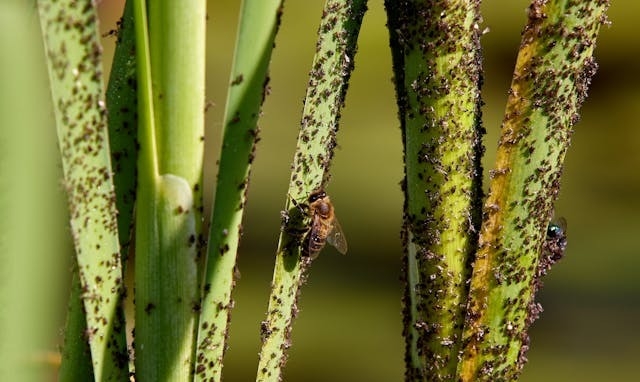What Are Tree Aphids and How Can You Deal With Them?
When you think about the most common pests in your landscaping, what comes to mind? If you’re like most people, you probably think of aphids. These insects are especially common on flowering plants and bushes. But did you know that there is a type of aphid that can take up residence in your trees? Tree aphids are becoming more common in the greater Denver area, and knowing how to spot these insects is key in keeping your trees healthy and thriving. Here’s what your plant health care team wants you to know.
What Are Tree Aphids?
Tree aphids are a type of aphid that prefers to feed, nest, and spend their time in your trees rather than the other plants in your yard. Like the aphids you find on flowering bushes, tree aphids can cause damage to your tree’s leaves and flowers.
Aphids are small and typically have translucent bodies that help them blend into the leaves for camouflage. These bugs are visible to the naked eye, but they can be hard to spot if you’re not sure what to look for.
Signs of an Infestation
Luckily, it’s easy to tell if you have a tree aphid infestation in your yard. Watch for the following signs:
Bubbling on the leaves: As aphids feed on the sap inside the leaves, they can cause warping in the structure of the leaves themselves. This may appear as bubbling along the surface in places where the leaves should be flat and smooth.
Wilting leaves: Leaching the sap out of the leaves can effectively cause the leaves to get dehydrated which leads to wilting. You may notice limp or wilted leaves throughout the canopy or just along a single branch.
Yellowing leaves: Once the leaves wilt, it’s likely that they’ll eventually yellow and die. If you see yellowing leaves in an otherwise healthy tree, you likely have an aphid infestation.
If you notice any of these warning signs, don’t ignore them. The sooner you contact a tree care specialist, the easier it will be to protect the rest of your tree.
What to Do If You Have a Problem
Though aphids can be a major nuisance, there are things you can do to deal with an infestation. You may be able to wipe the aphids off of the leaves with your hands or use a high-pressure setting on a spray nozzle to blast them away with your garden hose.
If removing the aphids isn’t enough or they’ve done some significant damage to your trees, you may need to schedule a tree trimming appointment to remove the damaged growth. Often, removing the damaged limbs will remove most or all of your active aphids. This can help you keep your trees looking great and growing healthily well into the future. Just make sure to work with a professional. They know how much of a limb can be safely removed at any given time.
Schedule an Appointment With Root Tree Service
If you’re worried about aphids in your trees or know you have an active infestation, don’t try to deal with the problem on your own. Contact Root Tree Service today to schedule an appointment with our plant health care specialists.
Go Back What Are Tree Aphids?
Tree aphids are a type of aphid that prefers to feed, nest, and spend their time in your trees rather than the other plants in your yard. Like the aphids you find on flowering bushes, tree aphids can cause damage to your tree’s leaves and flowers.
Aphids are small and typically have translucent bodies that help them blend into the leaves for camouflage. These bugs are visible to the naked eye, but they can be hard to spot if you’re not sure what to look for.
Signs of an Infestation
Luckily, it’s easy to tell if you have a tree aphid infestation in your yard. Watch for the following signs:
Bubbling on the leaves: As aphids feed on the sap inside the leaves, they can cause warping in the structure of the leaves themselves. This may appear as bubbling along the surface in places where the leaves should be flat and smooth.
Wilting leaves: Leaching the sap out of the leaves can effectively cause the leaves to get dehydrated which leads to wilting. You may notice limp or wilted leaves throughout the canopy or just along a single branch.
Yellowing leaves: Once the leaves wilt, it’s likely that they’ll eventually yellow and die. If you see yellowing leaves in an otherwise healthy tree, you likely have an aphid infestation.
If you notice any of these warning signs, don’t ignore them. The sooner you contact a tree care specialist, the easier it will be to protect the rest of your tree.
What to Do If You Have a Problem
Though aphids can be a major nuisance, there are things you can do to deal with an infestation. You may be able to wipe the aphids off of the leaves with your hands or use a high-pressure setting on a spray nozzle to blast them away with your garden hose.
If removing the aphids isn’t enough or they’ve done some significant damage to your trees, you may need to schedule a tree trimming appointment to remove the damaged growth. Often, removing the damaged limbs will remove most or all of your active aphids. This can help you keep your trees looking great and growing healthily well into the future. Just make sure to work with a professional. They know how much of a limb can be safely removed at any given time.
Schedule an Appointment With Root Tree Service
If you’re worried about aphids in your trees or know you have an active infestation, don’t try to deal with the problem on your own. Contact Root Tree Service today to schedule an appointment with our plant health care specialists.
